Text
Public Opinion in the JFK Library Archives: Jacqueline Kennedy’s Televised White House Tour, February 14 1962
This post was originally published on 2/14/2018
by Emily Mathay and Stacey Chandler, Archives Reference
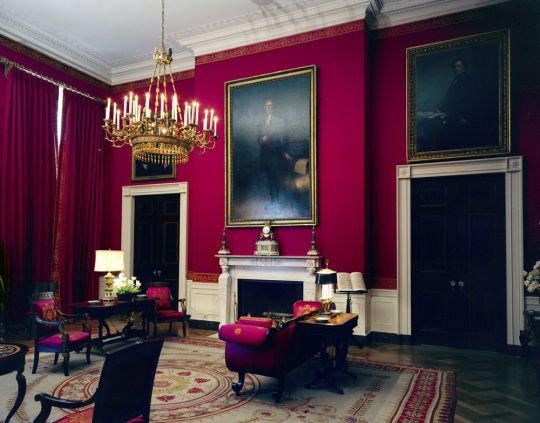
At 10 p.m. on February 14th, 1962, Jacqueline Kennedy brought millions of people into the country’s most famous house with her television special A Tour of the White House with Mrs. John F. Kennedy. Hosted by the First Lady and CBS correspondent Charles Collingwood, the tour was the public’s first look at Jacqueline Kennedy’s famed White House restoration project. After the broadcast aired, thousands of people wrote to the White House with their opinions. Their letters are now in the archives at the JFK Library, where we’re working on preserving them.
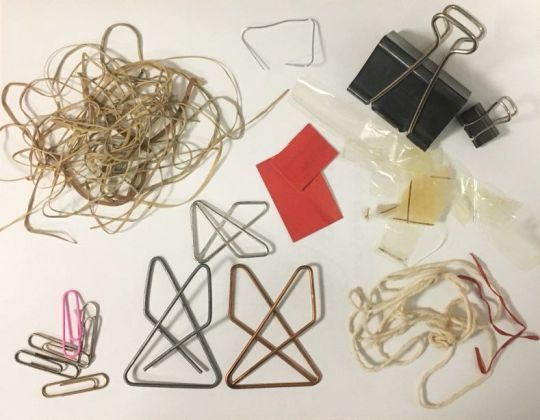
Image: A sampling of items archivists have removed from letters during preservation of the White House Public Opinion Mail.
By 1962, many Americans knew about Jacqueline Kennedy’s project to fill the White House with antiques from the time of its original construction; she had already helped create the White House Historical Association, the Fine Arts Committee, and the position of White House Curator. But her televised tour showcased the results of all that work for the first time, and invited the world to hear about the history she chose to preserve. The broadcast led many viewers to write to the White House with their own views about history – and the way political figures discussed it.
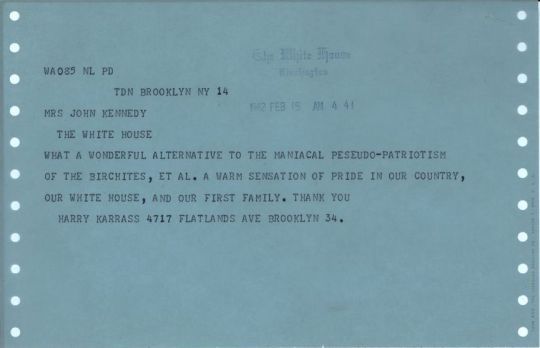
Image: JBKOPP-SF002-005-p0013

Image: JBKOPP-SF002-005-p0049
Most of the letters noted Jacqueline Kennedy’s appearance in some way, offering praise or criticism of her style, expressions, and tone of voice.
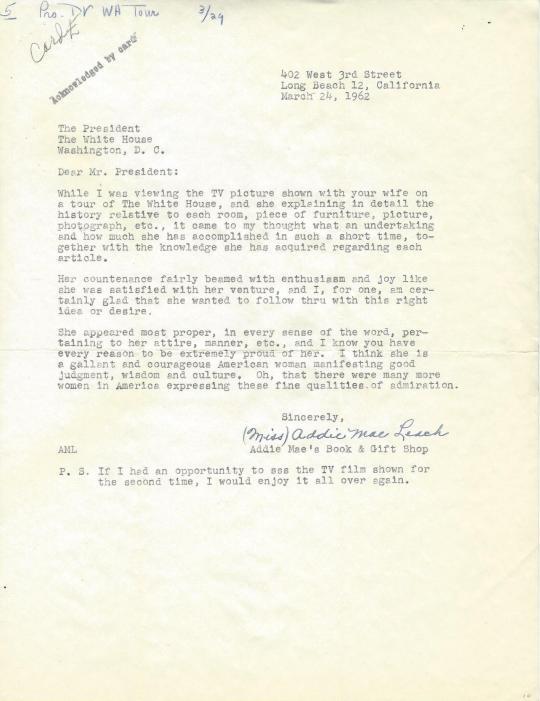
Image: JFKWHMPFPOM-0659-005-p01

Image: JBKOPP-SF002-005-p0104
Some messages offered thoughts (positive and negative) about the content of the tour itself, including personal connections to the history and art the First Lady talked about.

Image: WHSF_947_22-p09
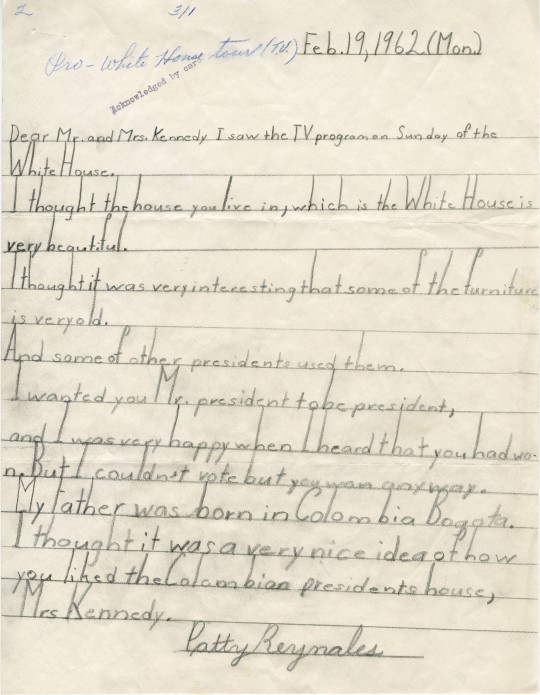
Image: JFKWHMPFPOM-0658-005-p01
Others sent in clippings of positive reviews, requested for photographs of the First Family, or asked questions the tour hadn’t quite answered for them. A common question from kids who watched the black-and-white broadcast: are rooms like the Red Room really decorated in the colors they are named after?
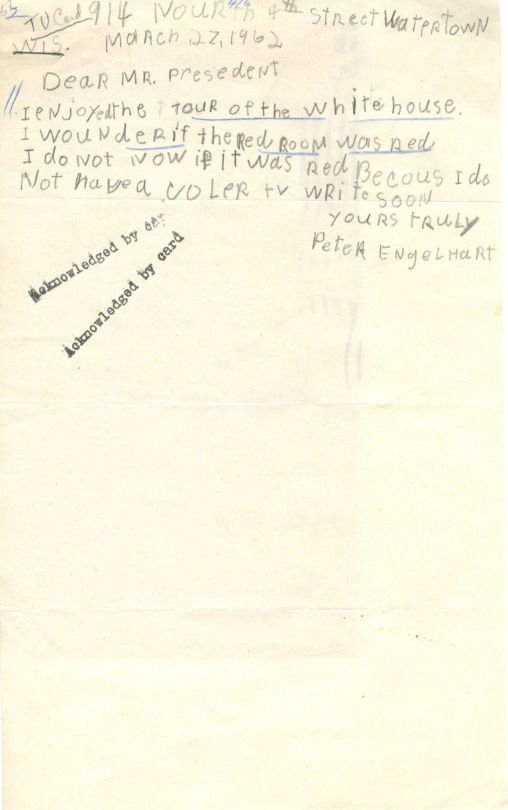
Image: JFKMPFPOM-0659-04-p18
Throughout the boxes of letters, one unexpected figure pops up: Astronaut John Glenn, who blasted into space in the Mercury capsule Friendship 7 just six days after the First Lady’s tour. Letters to the White House often comment on both the White House Tour and Glenn’s success, creating a documentary record of public reaction to both the intimate and the (quite literally) ‘out of this world.’
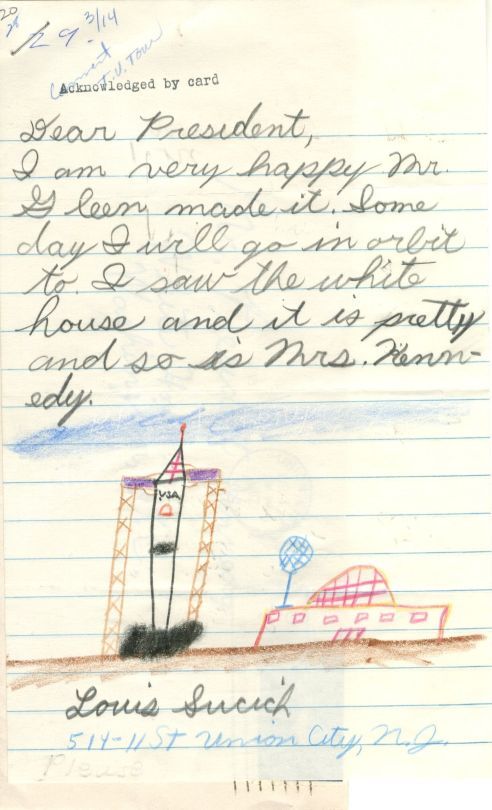
Image: JFKMPFPOM-659-04-p10
A month after the broadcast, a new Nielson report noted that the number of White House visitors in the first week of March had increased by over 5,000 from the previous year. Though we can’t be sure that the dramatic uptick was a result of the First Lady’s broadcast, letters from the public reflect an overwhelmingly positive response to the preservation of the nation’s past even as it began to explore the new frontiers of the future.
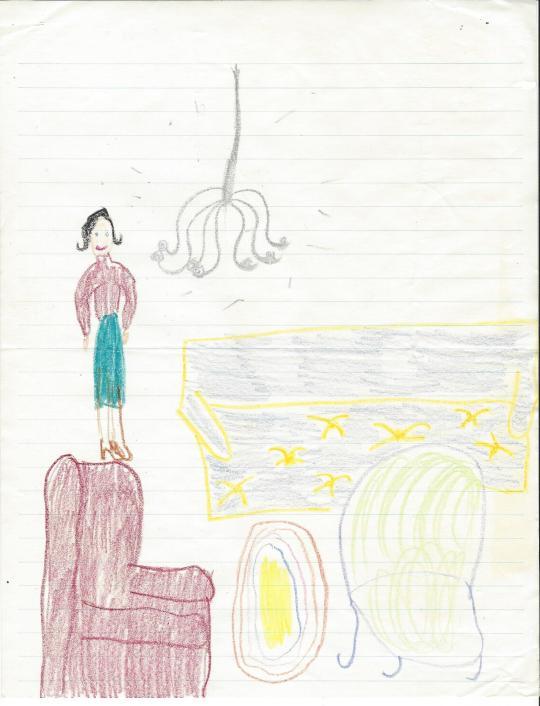
Image: JFKMPFPOM-659-02-p49
24 notes
·
View notes
Text
#ReflectionsOnLoss
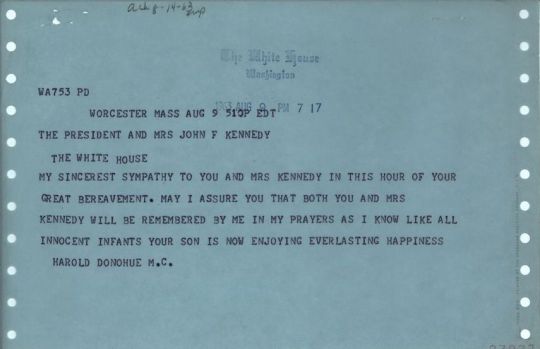
Condolence telegram from Rep. Harold Donahue. JFKWHCSF-0707-014-p0002
cw: death of a child
On August 7, 1963, First Lady Jacqueline Kennedy gave birth to a baby boy, who she named Patrick Bouvier Kennedy. He had been born 5 ½ weeks prematurely, and it was soon discovered that he suffered from a lung ailment called Hyaline Membrane Disease (now also known as also called Respiratory Distress Syndrome). At the time, the rate of survival was 50/50. Patrick was rushed to Boston Children’s Hospital, where doctors attempted to save his life and President Kennedy stood watch over him. He died two days later on August 9; news of his death traveled across the globe, and people throughout the world sent their condolences to the First Family.
While available records at the JFK Library don’t give us first person accounts of what the President and First Lady felt through the birth and loss of their child, interviews with family and friends and other associates who were there give us a glimpse in the private grief of a public family.

Kennedy family in Hyannis Port, August 4, 1962. ST-22-1-62
Pamela Turnure (press secretary to Mrs. Kennedy) on the private side of the Kennedy family and the public nature of Patrick's’ death (link)
...Up to then even though there had been quite a few candid pictures of the Kennedy family together and some idea of what they were like as a family, that basically they had a marvelous reserve and they never wanted to sort of flaunt themselves as a family and show their innermost feelings for one another.
When this happened, for the first time the inner life of the family became terribly open to the world, and what the President particularly and Mrs. Kennedy particularly felt for one another became apparent to the world, and this was something that people who admired them as a head of state and his wife, had really never known what they were like as a family until this moment. Suddenly it was all in the open, and the President’s real devotion to Mrs. Kennedy and to the children—all of it—was a new side that had never been seen so microscopically before.
Nancy Tuckerman (social secretary to Mrs. Kennedy) and Pamela Turnure on President Kennedy’s reaction to Patrick’s birth (link)
Tuckerman: He sat, I think for one whole night in this chamber that they placed the baby in—by the baby—he sat there with the baby until he died, I believe, or until they knew it was absolutely hopeless. And then he—well what an emotional time to go through anyway—suddenly to be called on the phone and told she was going to the hospital—and at that moment really not knowing whether her life was in danger—the trip up—you know, he was very—I remember going up on the plane—he was...
Turnure: He was very withdrawn at that time. He just kept sitting and staring out of the window, and obviously his thoughts were completely with her, and it was a very quiet trip—getting there as soon as possible—rushing to the hospital—and... I had seen that look once before. It was time again back to when John was born. I remember that look on his face when he got the word, “Come back.” They had been through some terrible, terrible times together, and I think this was the first time the international public saw him as a President with family tragedy...
Janet Auchincloss (Jacqueline Kennedy’s mother) on President Kennedy’s concern for the First Lady (link)
I remember his saying to me in the hospital in Boston that day, when Patrick was in the little incubator and then before we went down in the iron lung room, which they tried as a last resort to help his breathing, I remember his saying to me... “Oh, nothing must happen to Patrick because I just can't bear to think of the effect it might have on Jackie.” I could see the effect it might have on him, too.

Press Secretary Pierre Salinger (in profile) briefs the press, August 9, 1963. ST-A6-1-63
Nancy Tuckerman and Pamela Turnure, on the lack of privacy at the hospital (link)
Tuckerman: I remember thinking how terrible it was that they had no privacy even in the face of tragedy, because the press was—there were so many of them just standing outside the hospital door—like vultures, waiting for some kind of a message that we couldn’t possibly open the door to go for a walk because they would just descend upon you.
Turnure: Well, that’s part of American life though and then being the President of the United States and that—I don’t think it could have been handled any other way... If she had said, “I cannot go through with it,” then it would have been done some other way. But she said, “Yes, I can do it.”
Maud Shaw (nurse to Caroline and John Jr.) on the children’s awareness of their brother’s death (link)
[W]e had told the children they were going to have a brother or sister and then they had to be told that their brother was not coming home - that he had been sick and he had gone to heaven. I saw a part of the President I had never seen before. I had always thought him a very good father but my opinion since then that he should have had a large family, that he proved himself a wonderful father. The concern about his child' s birth and illness and death was really astounding to me...
He told Caroline what had happened. To John he had said that the baby wasn't coming home. But John was not old enough to take in too much. But Caroline was very concerned about it
Cardinal Cushing (Roman Catholic Archbishop of Boston) on the funeral Mass held for Patrick (link)
Only the members of the family were present. Jacqueline was too sick. Cardinal Spellman came from New York...There was nobody else outside of myself and the family. All the family arrived for the services in helicopters. They landed in the ball field of the seminary.
I wrote a special prayer that I gave to Jacqueline after I read it at the end of the Mass. Then they all filed out, and for the second time I saw tears in the eyes of Jack Kennedy, and they were copious tears. He was the last of the family to leave the little chapel. I was behind him. The casket was there. It was in a white marble case. The President was overwhelmed with grief that he literally put his arm around that casket as though he was carrying it out. I was right behind him. I said, “Come on, Jack. Let’s go. God is good. We’re only about ten minutes from the cemetery.”... A few moments after our arrival at the grave, the casket that had been placed in a bronze container was gently, silently, and devoutly placed in the bosom of the earth.

Clint Hill (2nd from right) outside hospital with other Secret Service agents, August 9, 1963. ST-A6-3-63
Clint Hill (Mrs. Kennedy’s Secret Service Agent) on Patrick’s birth and the aftermath (link)
They put [Mrs. Kennedy] in a helicopter and brought her to Otis. I raced to Otis by car. I got there about the same time. And Dr. Walsh came, and she delivered a little boy. They named him Patrick Bouvier Kennedy. He developed serious lung problems. And they decided that they’d have to transport him to Boston.
In the interim, the president was in Washington at the White House. So we notified him what was going on... He came right to the hospital to see her. And we had taken Patrick by that time to Boston. Agent Landis had gone with him. And then, the president went to Boston to be with Patrick. They didn’t, at first, think it was going to be that serious. But turned out, it was very serious, and he died two days later...
I stayed at Otis Air Force with her. The president came and told her what had happened. The funeral was held in Boston... She was not able to go because she was at Otis in the hospital.
And she went into a very deep depression. She was very upset. And it was decided that maybe she needed to get away for a while. And so, it was arranged for her to go to Greece and go on a cruise.
#ReflectionsOnLoss#ChildLossAwarenessDay#JacquelineKennedy#JohnFKennedy#PatrickBouvierKennedy#OralHistories
22 notes
·
View notes
Text

(AR8035-C)
Did you know JFK had a formal White House visit with a troll? It’s true! Pictured, President Kennedy meets pilot Betty Miller (who completed the first solo flight by a woman across the Pacific Ocean) and “Dammit,“ the troll doll who joined her for the trip!
Betty Miller was a helicopter and plane pilot who ran a flight school with her husband in Santa Monica, California. In 1963, she became the first woman to fly solo across the Pacific Ocean, flying from California to Australia. In total, she flew 7,415 miles, which took over 51 hours of flight time to complete.
Two months after her flight, she received the FAA’s Decoration for Exceptional Service, and showed JFK and FAA Administrator Najeeb Halaby the route of her flight.
250 notes
·
View notes
Text
For Better, For Worse: Meet the Mrs. Hemingways
by Hilary Justice, Hemingway Scholar in Residence, with Hannah Driscoll, Hemingway Intern
Hemingway found inspiration everywhere, notably in his relationships with his first fiancée and his wives. Their personalities appear in his characters, and aspects of their relationships and experiences they shared with the writer enrich almost all of his works. From his time as an ambulance driver in WWI Italy through 1920s Paris, life on the Gulf Stream, living in Key West and outside Havana, Cuba, covering major European wars and going on two safaris in eastern Africa, life with Hemingway was often an adventure—perhaps made more so by later appearing in his works, whether in fiction, non-fiction, or something in-between. No one could understand the sources of Hemingway’s inspiration better than the women who knew him most intensely, for better, for worse: the four women who married him, and one who almost did.

Agnes von Kurowsky at the Red Cross Hospital, Milan, Italy, 1918 (EHPH 06897)
Hemingway’s first love was Red Cross nurse Agnes von Kurowsky, whom he met while being treated for war wounds in Milan, 1918, right around his 19th birthday. According to her diary and letters, what started as a mildly flirtatious relationship quickly became serious. Although she was on his nursing team, a mild flirtation wasn’t considered unprofessional; on the contrary, keeping wounded soldiers’ spirits up was part of a WWI nurse’s job, and that was an accepted way to do it, up to a point. She was several years older than he, and she held that line with her nickname for him, “Kid.” But Hemingway was in love, and he countered by calling her “Mrs. Kid.” She resisted taking things seriously for a while, referring to him freely in her diary, which could be found and read. But when her feelings also grew serious, she stopped writing in her diary, instead writing long letters to him in secret. In these letters, you can read her love and her doubts; eventually, she admits her feelings, imagines their future, and signs herself “Mrs. Kid.”
Their relationship did not last. When their wartime paths separated them (he returned stateside while she remained in Italy), her doubts intensified, and she wrote to him, ending their relationship. Their romance and its end first inspired Hemingway to write “A Very Short Story” (in the first edition, the character’s name is “Ag”; he changed it to “Luz” for the second). Hemingway’s real heartbreak very subtly informs “Big Two-Hearted River,” in which the war is never referenced but permeates everything. An early draft of that story hints at the storm scene a few years later in A Farewell to Arms, in which setting, situation, and the character Catherine Barkley all owe much to Agnes and her wartime romance with the young Ernest.
The JFK Library holds the Agnes von Kurowsky papers. Read her wartime diary.
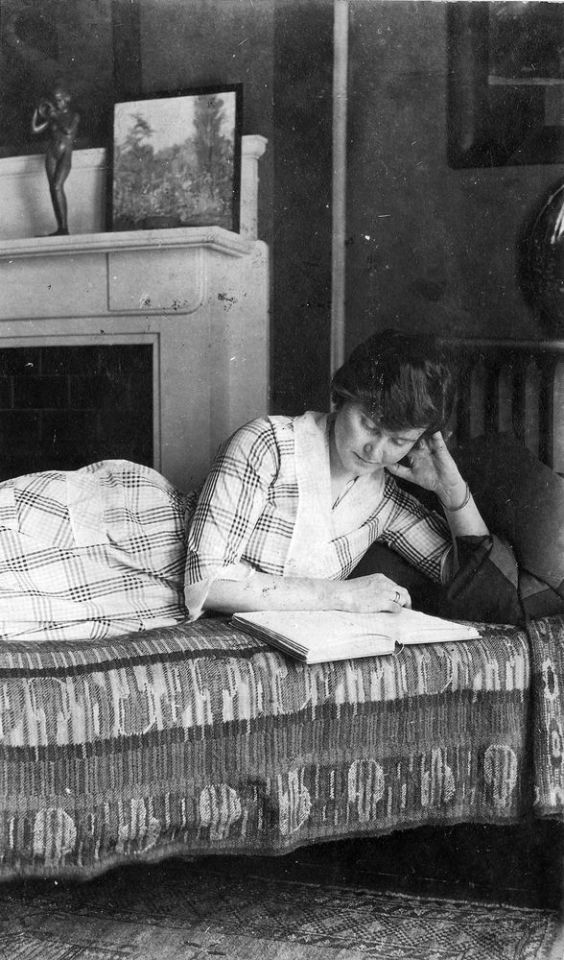
Hadley Hemingway in their first Paris apartment, Summer, 1922 (EHPH 09543)
Hemingway immortalized his first wife, Hadley Richardson Hemingway, in one of his most popular works, the posthumously published A Moveable Feast, which recounts their marriage, the entirety of which they spent in 1920s Paris. The couple met at a party in Chicago, when Hemingway was at loose ends, physically recovered from his war wounds but still carrying the emotional weight which would haunt him for his entire life. Like Agnes, Hadley was several years older than Ernest; she, too, was at loose ends. From this unlikely and rather murky beginning, they married at his family’s summer home in Northern Michigan and, at the advice of writer Sherwood Anderson (an early mentor of Hemingway’s), moved to Paris’s Left Bank to join the artistic expatriate community.
For a young woman of Hadley’s cultural moment and demographics, a focus on marriage and family was considered normative and respectable. She was the only one of Hemingway’s wives never to have a career outside the home; in being Mrs. Ernest Hemingway and, later, mother to their son John (Bumby; later, Jack) Hemingway, she fulfilled her initial ambitions for her adult roles. Neither her life nor her adventures ended when their marriage did; she married another Paris expatriate, journalist Paul Mowrer, who became close to young Jack. Through her new husband, she met the artist Paul Child. All three would return to Paris after WWII, when Hadley met the new Mrs. Child, Julia. (Yes, that Julia Child!) Hadley gets a curtain call in American literature in Julia Child’s My Life in France: the couples were good friends, and Julia was matron-of-honor at Jack Hemingway’s wedding.
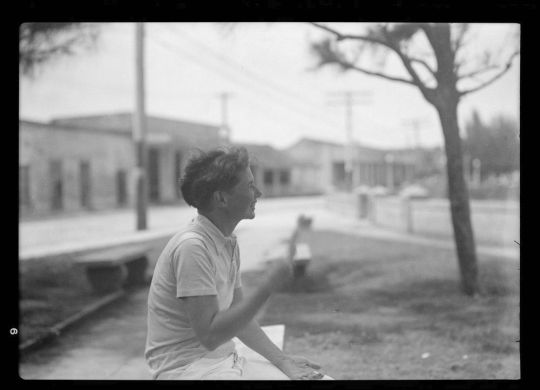
Pauline Hemingway in Cojímar, Cuba, early 1930s (photograph by Ernest Hemingway; EHPP 01850N)
Among the later members of the 1920s expatriate community were American sisters Pauline and Ginny Pfeiffer. They soon joined the Hemingways’ social circle, and, as Hemingway writes in A Moveable Feast, Ernest had the misfortune to fall in love with Pauline while still in love with Hadley. Hadley declared that if Ernest and Pauline agreed to stay apart, with no contact for 100 days, and still wished to be together, she would grant him a divorce so they could marry.
Pauline returned to her parents’ home in Arkansas, and she and Ernest proceeded to correspond in secret—just as he and Agnes had done in Italy. In early 1927, knowing that Pauline’s mother, a devout Catholic, was arguing hard against her breaking up a marriage and family, and knowing that Pauline had a job offer from Vogue magazine in New York, he pulled out all the stops in a letter, claiming that ending a relationship when both people loved each other was like “an abortion,” saying he felt “all shot to hell inside.” Thus persuaded, Pauline agreed to marry him; Hadley, having met Paul Mowrer, called off the 100 days’ separation early, and Pauline sailed for France. On their honeymoon in Provence that May, Hemingway wrote “Hills Like White Elephants” (a story concerning, among other things, an abortion decision); their honeymoon in the seaside town Le Grau du Roi figures again in The Garden of Eden.
Pauline and Ernest moved to Key West in 1928, when she was expecting their first child, Patrick; their home there is now a museum and home to descendants of Hemingway’s famous polydactyl cats. They welcomed their second child, Gregory, in 1931. With the 1929 publication of A Farewell to Arms, Hemingway’s reputation and career were secure, and they enjoyed the patronage of Pauline’s wealthy uncle Gus Pfeiffer. Uncle Gus underwrote their 1933-34 African safari because, he said, he wanted to read the book Hemingway would write about it. By now, Hemingway was known to his children and friends as Papa; Pauline appears in the non-fictional Green Hills of Africa as “P.O.M”—Poor Old Mama—and facets of their relationship are refracted through later composite characters as well, including Helen in “The Snows of Kilimanjaro” and both Catherine and Marita in The Garden of Eden.

Martha Gellhorn at the Finca Vigía, San Francisco de Paula, Cuba, March 1940 (EHPH 00806)
In 1936, Hemingway’s love for Spain, its culture, and its people had him following the developing Spanish Civil War with an increasingly troubled soul. Late that year, he met established journalist and war correspondent Martha Gellhorn in Key West; they agreed to work together to get to Spain. His literary career in the 1930s seemed to be ebbing (critics were saying “permanently”). And although he certainly benefited from Pauline’s family resources, that also must have chafed. His journalism career, now existing in part because of his famous name, was ongoing; covering the Spanish Civil War thus seemed a good idea in many ways.
Martha, who is now considered one of the finest war correspondents of the 20th century, was in every way a spur to Hemingway’s ambitions. Where he feared he was growing comfortable and soft, she was a strong individual who seemed to seek out discomfort. Where he was approaching his middle years, she seemed vital and vigorous. Whether or not they were already romantically involved before they left for Spain remains a question, as thoughts and feelings happen before they appear on paper; in any case, their relationship ignited while abroad. Hemingway remained with Pauline until 1939, during which time his relationship with Gellhorn intensified, in part because she seemed elusive, traveling frequently on high-profile assignments, covering increasing political turmoil in Europe.
Her presence and experiences with him in wartime Spain (and perhaps her long absences from him afterward) were fundamental to his novel For Whom the Bell Tolls, which he dedicated to her. She lends her appearance to Maria, and her strength, toughness, and fierce loyalty and commitment to both Maria and Pilar. (Pilar, a composite character, also owes much to Gertrude Stein.) The sale of the novel’s movie rights marks the first time in Hemingway’s career that his literary income was sufficient to live on; he no longer needed to work as a journalist or rely on wealthy relatives-by-marriage. (His extended family responsibilities included members of his family of origin in addition to his children, and his own high-profile lifestyle was not inexpensive.)
Gellhorn’s rising star and dauntless pursuit of her journalistic calling, though, sparked a darker side of Hemingway: his competitiveness and his insecurity. The combination proved disastrous to their relationship. During the build-up to D-Day (June 6, 1944), she informed him she was leaving for Europe to cover the war for Collier’s magazine. He did not want to go, perhaps because he did not want to relive past trauma in a third war, but when it became clear he couldn’t convince her to stay with him in Cuba, he offered his own services as war correspondent to the very same magazine. His fame won out, as he must have known it would. He received a contract. She was furious.
Journalists were prohibited from crossing the Channel on D-Day. Hemingway obeyed, delaying his crossing until the next day. But Martha snuck aboard a medical ship, hiding in a closet, and arrived in Normandy only hours after the battle, giving her first-hand experience of its aftermath. Check. But when their pieces appeared in Collier’s, his was the cover story. Check mate. The marriage was over.

Mary and Ernest Hemingway on safari, 1953-54 (EHPH C00542)
In London, while awaiting D-day, Hemingway met another war correspondent, Mary Welsh, who was ultimately to become his last wife, later his widow, and the initial custodian of his legacy. After the war, she joined him in Cuba, where they were to live until the Revolution forced a permanent residence in the U.S., in Ketchum, Idaho. She recounts their life together in the autobiographical How It Was, but, as with her predecessors, she too proved inspiring in Hemingway’s last works, especially True at First Light, the “fictional memoir” of their 1953-54 safari.
Her influence on other works is more subtle. She knew and became friends with Pauline Pfeiffer while Patrick Hemingway (Pauline’s son with Ernest) was at the Finca Vigía recovering from an illness. Mary had been called back to the States to deal with family matters; Pauline flew to Cuba to care for her son. After Mary returned, their friendship grew. That friendship and aspects of Mary’s personality and appearance are reflected in composite characters and some of the details of The Garden of Eden.
Mary and Ernest Hemingway’s marriage had more than its share of difficulties, foremost among them his failing health and despair, all exacerbated and accelerated by the severe head injury he suffered in a plane crash while in Africa. After the Revolution in Cuba, both decided that, as Americans, they could no longer return, whether or not they wanted to. Although they both loved their final home Idaho, which they decorated with mementos from their travels, their lives there were shadowed by mourning and increasing loss, enlivened only in fleeting moments – a chance encounter with a friendly dog; nursing an injured bird back to health—coming to an end with Hemingway’s suicide on July 2, 1961.
Mary donated the Ernest Hemingway Collection to the JFK Library and established the annual PEN/Hemingway Award. She divided her time between Idaho and New York until her death in 1986.
#Ernest Hemingway#Hemingway PBS#Agnes von Kurowsky#Hadley Richardson#Pauline Pfeiffer#Martha Gelhorn#Mary Hemingway
73 notes
·
View notes
Text
Founded in 1896, the National Association of Colored Women’s Clubs merged multiple organizations, large and small, into one association whose common goals were to support racial and gender equality.
The NACWC continued their work well into JFK’s administration, including advocating that Frederick Douglass’s home be made into a National Park. The organization’s president Dr. Rosa Gragg wrote to Ken O’Donnell, Special Assistant to the President in early 1962 with their request.
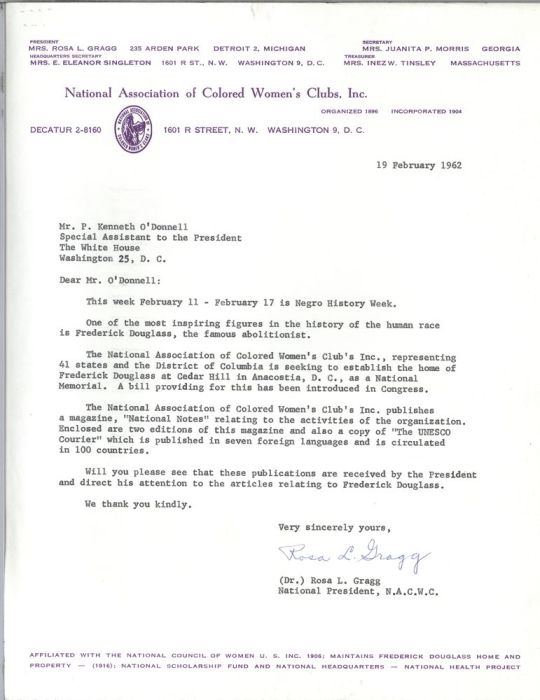
JFKWHSFHW-005-005-p0008 Letter from Dr. Rosa Gragg to Kenneth O’Donnell
In 1962, JFK signed a bill doing just that, and members of the club, including their president Dr. Rosa Gragg, were present at the singing.
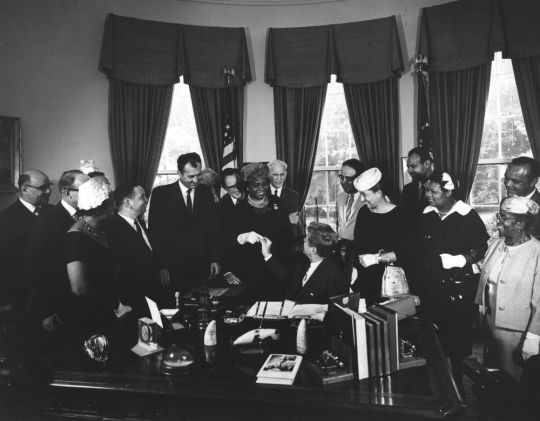
AR7448-C. President John F. Kennedy Designates Frederick Douglass Home Part of National Park System
A month before that, they gifted President Kennedy a portrait of President Lincoln that hung in Douglass’ house. This would be the first time that a US president accepted a gift from a Black organization.

ST-336-2-62. President John F. Kennedy with Members of the National Association of Colored Women's Clubs
18 notes
·
View notes
Photo

“As we express our gratitude, we must never forget that the highest appreciation is not to utter words, but to live by them.” - John F. Kennedy, 1963 Thanksgiving Day Proclamation
74 notes
·
View notes
Photo

“When the President came to the office the morning of October 29, 1962 he was thinking about a memento that he could give to all of those who participated in the meetings during the Cuban crisis. The one thing that was fixed in his mind was the idea of having the month of October on some kind of a background with the dates 16-28 either circled or standing out in a different print. He first thought of a lucite cigarette box... Then he thought there might be some who did not go in for cigarette boxes so he thought of the idea of having the calendar engraved on a silver plate to be attached to a piece of wood with the dates 16-28 in larger print. And he thought it would be nice to have his initials in one corner and the donee’s initials in the other...
“The calendars arrived on Wednesday, November 28th, so on the morning of November 29 the President wanted them so that he could pass them out at the National Security Council Executive Committee meeting at 10:00 am. So the blue boxes containing the calendars were placed by his chair in the Cabinet Room and after everyone had been seated, and just before the meeting started, he distributed them. The men who did not attend the meeting received theirs either by hand delivery or by mail.
“The President surprised me by having one made up for me and just before he went into the Cabinet Room that morning he handed it to me.”
- Evelyn Lincoln’s description of the Cuban Missile Crisis memento, JFKPOF-098-007-p0007
33 notes
·
View notes
Text
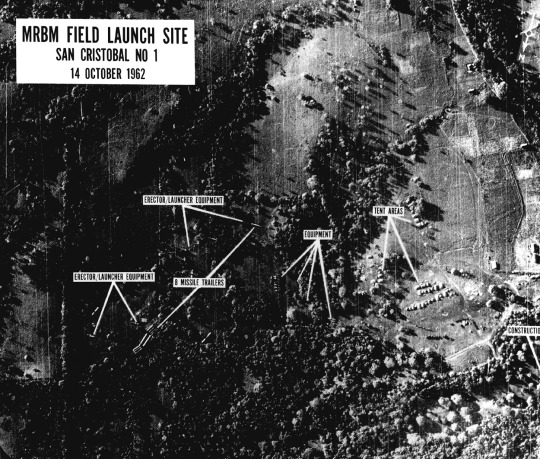
At 8:45 AM on October 16, 1962, National Security Advisor McGeorge Bundy alerted President Kennedy that a major international crisis was at hand. Two days earlier, a United States military surveillance aircraft had taken hundreds of aerial photographs of Cuba, which showed conclusive evidence that a Soviet missile base was under construction near San Cristobal, Cuba.
Discussions began on how to respond to the challenge. Two principal courses were offered: an air strike and invasion, or a naval quarantine with the threat of further military action. To avoid arousing public concern, President Kennedy maintained his official schedule, meeting periodically with advisors to discuss the status of events in Cuba and possible strategies.
📷One of the first images of missile bases under construction shown to President Kennedy on the morning of October 16.
109 notes
·
View notes
Text
Kennedy Family Collection Nitrate Negative Project: Fun in the Sun
From the early 1900s to about 1950, the Kennedy and Fitzgerald families documented their lives on nitrate photographic film. They were part of a new generation of amateur photographers utilizing a new medium that enabled them to produce numerous snapshots of everyday life – of friends and relatives, trips, holidays, and other celebratory occasions. When nitrate film became commercially available in the late 1880s, it made possible technical advancements in amateur roll film for smaller, more mobile cameras, ushering in the practice of family photography.
More than a century later, the surviving nitrate negatives from the Kennedy Family Collection have been digitized due in part to the inherently fragile and unstable nature of the medium but also to provide greater access and ensure future use while the physical objects remain safely preserved in their original format and condition.
The JFK Library is pleased to announce the completion of an 18-month grant project to catalog and provide online access to these newly digitized materials. Archivists created robust descriptions and metadata records for all of the nitrate negatives in the collection so that users can browse, search, and discover these historic photographs. Over 1,700 photographs are now available on the Library’s website. The nitrates represent a subset of photographic materials in a collection that provides access to the more personal, private moments of this prominent family not found in other historical sources.
These photos – the fourth and final in a series of posts to highlight images from this cataloging project - feature the Kennedy family enjoying outdoor leisure time together, whether at the beach in Hyannis Port, in the pool in Palm Beach, or on vacation with family and friends. These images highlight the Kennedy family’s affinity for the water – both ocean and pool, stateside and abroad.
To browse all of the Kennedy Family Collection photos that show the family (and others) swimming and participating in other sports and recreational activities, visit the Digital Archives.
Photographs © John F. Kennedy Library Foundation.
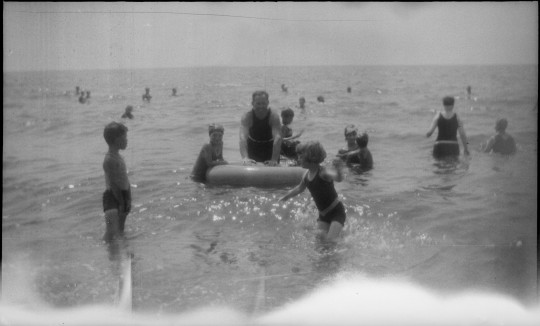
KFC31N. Joseph P. Kennedy, Sr., Swims with His Children at the Beach in Hyannis Port, ca. 1925

KFC621N. John F. Kennedy Swims at the Beach in Hyannis Port, ca. 1925-1926

KFC117N. Rosemary Kennedy, Eunice Kennedy, and Betsey Cushing Roosevelt Sit Poolside in Palm Beach, Florida, 1934

KFC1017N. Rosemary Kennedy and Kathleen Kennedy Swim at The Breakers Hotel in Palm Beach, Florida, March 1934
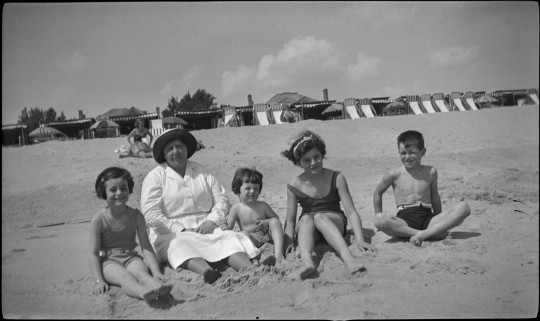
KFC1013N. Kennedy Family Children with Nanny Katherine Conboy at Breakers Beach in Palm Beach, Florida, March 1934

KFC304N. Patricia Kennedy, Robert F. Kennedy, and Jean Kennedy Play in the Pool in Palm Beach, Florida, March 1934

KFC109N. Joseph P. Kennedy, Sr., with Edward M. Kennedy at the Pool in Palm Beach, Florida, March 1935

KFC209N. Edward M. Kennedy with Edward E. Moore and Mary Moore at the Pool in Palm Beach, Florida, ca. March 1936

KFC583N. Joseph P. Kennedy, Sr., and His Family Go Swimming in Palm Beach, Florida, April 1936

KFC1403N. Joseph P. Kennedy, Jr., at a Beach Near Cannes, France, 1939: July-August

KFC1635N. Kathleen Kennedy Swims in Pool at Schweppe Family Estate in Lake Forest, Illinois, July 1941

KFC1722N. Joseph P. Kennedy, Jr., Robert F. Kennedy, Edward M. Kennedy, and a Friend Go Swimming in Palm Beach, Florida, December 1941-January 1942
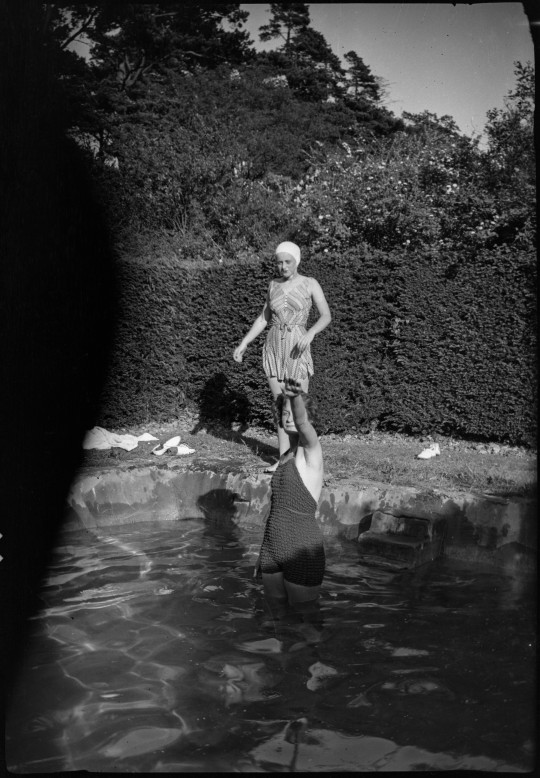
KFC1863N. Kathleen Kennedy and Unidentified Woman Swim at Country Estate in England, ca. 1943-1944
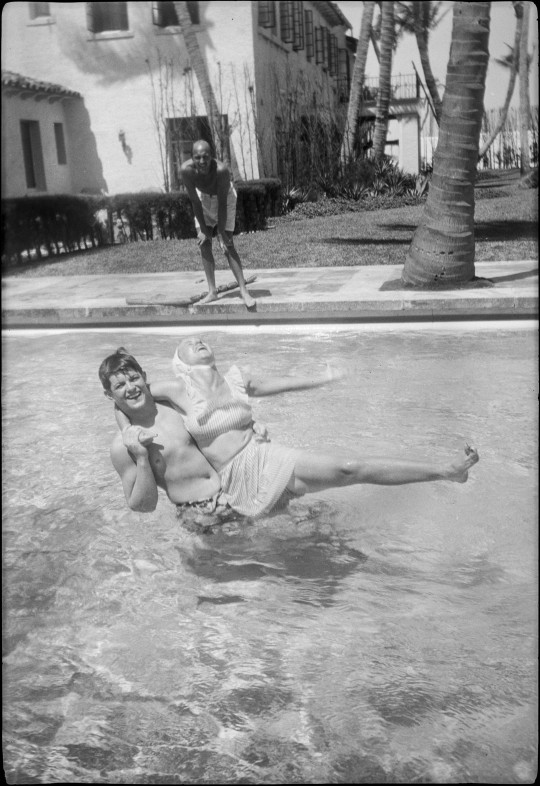
KFC2759N. Kathleen Kennedy Cavendish and Edward M. Kennedy Play in the Pool in Palm Beach, Florida, ca. 1946-1948
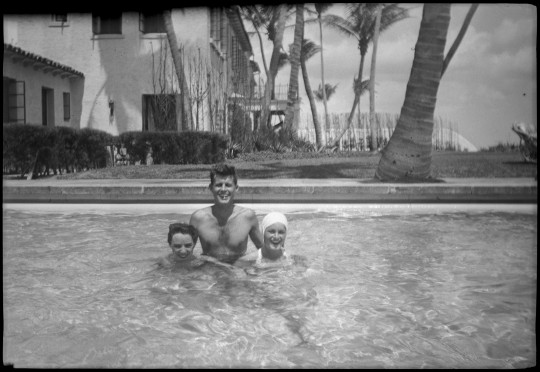
KFC2776N. John F. Kennedy, Jean Kennedy, and Ethel Skakel Go Swimming in Palm Beach, Florida, ca. 1946-1948
Read more about this project on the Library’s Blog.
#kennedy family#john f. kennedy#jfk#nitrate negatives#black and white photographs#hyannis port#palm beach#Illinois#Cannes
150 notes
·
View notes
Text
Kennedy Family Collection Nitrate Negative Project: John F. “Honey Fitz” Fitzgerald
From the early 1900s to about 1950, the Kennedy and Fitzgerald families documented their lives on nitrate photographic film. They were part of a new generation of amateur photographers utilizing a new medium that enabled them to produce numerous snapshots of everyday life – of friends and relatives, trips, holidays, and other celebratory occasions. When nitrate film became commercially available in the late 1880s, it made possible technical advancements in amateur roll film for smaller, more mobile cameras, ushering in the practice of family photography.
More than a century later, the surviving nitrate negatives from the Kennedy Family Collection have been digitized due in part to the inherently fragile and unstable nature of the medium, but also to provide greater access and ensure future use while the physical objects remain safely preserved in their original format and condition.
The JFK Library is pleased to announce the completion of an 18-month grant project to catalog and provide online access to these newly digitized materials. Archivists created robust descriptions and metadata records for all of the nitrate negatives in the collection so that users can browse, search, and discover these historic photographs. Over 1,700 photographs are now available on the Library’s website. The nitrates represent a subset of photographic materials in a collection that provides access to the more personal, private moments of this prominent family not found in other historical sources.
These photos – the third in a series of posts to highlight images from this cataloging project - feature former Mayor of Boston, John F. “Honey Fitz” Fitzgerald, pictured alone or with his wife, Mary Josephine Hannon Fitzgerald, and their children and grandchildren. The following images offer glimpses into Honey Fitz’s personality, his family and public service life, and the keen interest he held for his Irish heritage.
To browse all of the Kennedy Family Collection photos in which John F. “Honey Fitz” Fitzgerald appears, visit the Digital Archives.
Photographs © John F. Kennedy Library Foundation.

KFC1429N. Mayor John F. Fitzgerald and Rose Fitzgerald Aboard R.M.S. Franconia, ca. June 27-August 16, 1911
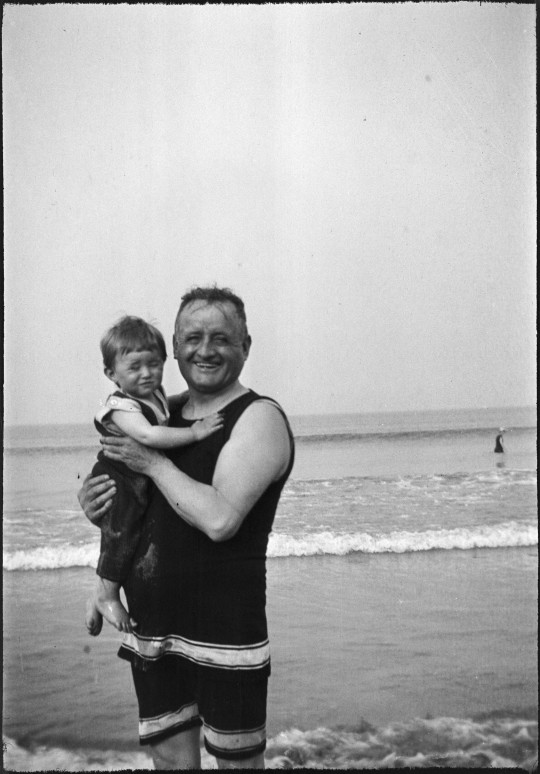
KFC887N. John F. "Honey Fitz" Fitzgerald with Joseph P. Kennedy, Jr., at Nantasket Beach, ca. 1916
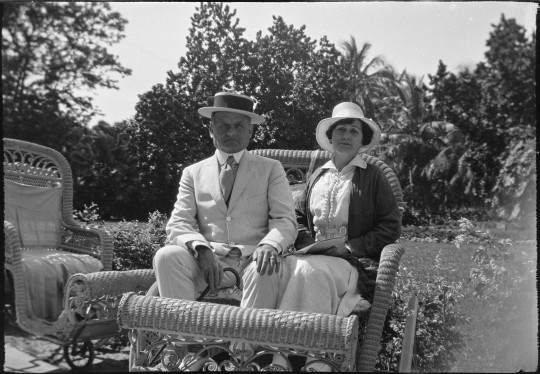
KFC803N. John F. Fitzgerald and Mary Josephine Fitzgerald in Palm Beach, Florida, ca. 1915-1916
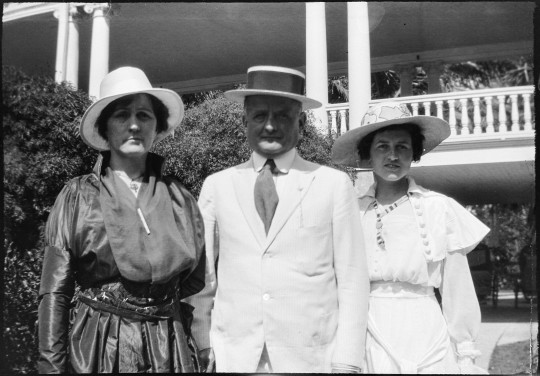
KFC807N. John F. Fitzgerald, Mary Josephine Fitzgerald, and Rose Fitzgerald Kennedy in Palm Beach, Florida, ca. 1915-1916

KFC232N. Kennedy Family Children with Their Grandparents, John F. Fitzgerald and Mary Josephine Fitzgerald, in Cohasset, ca. 1922

KFC211N. Kennedy Family Children with Their Grandparents, John F. Fitzgerald and Mary Josephine Fitzgerald, in Cohasset, ca. 1922
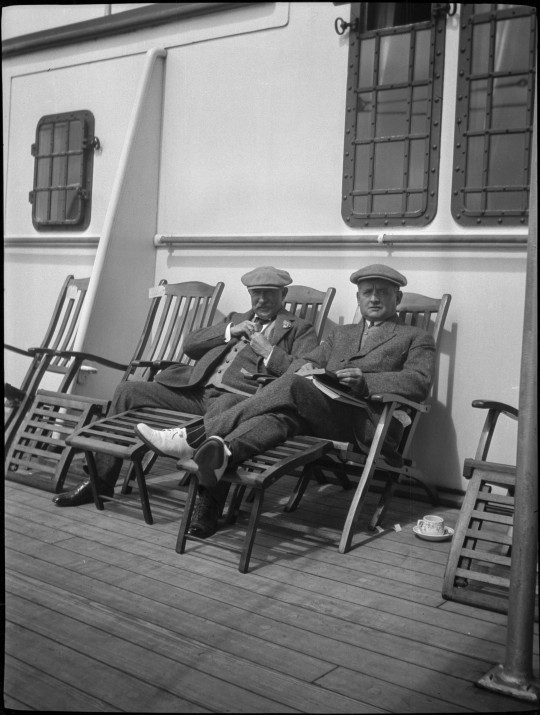
KFC1422N. Mayor John F. Fitzgerald with John Hays Hammond, Sr., Aboard R.M.S. Franconia, ca. June 27-August 16, 1911

KFC1559N. Mayor John F. Fitzgerald and Boston Chamber of Commerce Delegates at Residence of Sir Thomas Lipton in England, ca. July 5, 1911

KFC1481N. Mayor John F. Fitzgerald with Rose Fitzgerald, Agnes Fitzgerald, and Hugh Nawn Aboard Sir Thomas Lipton's Yacht in England, ca. August 7, 1911
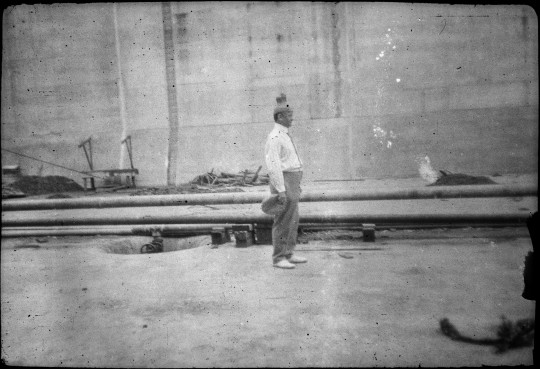
KFC240N. Mayor John F. Fitzgerald at Gatun Locks in Panama, ca. May 1-4, 1913
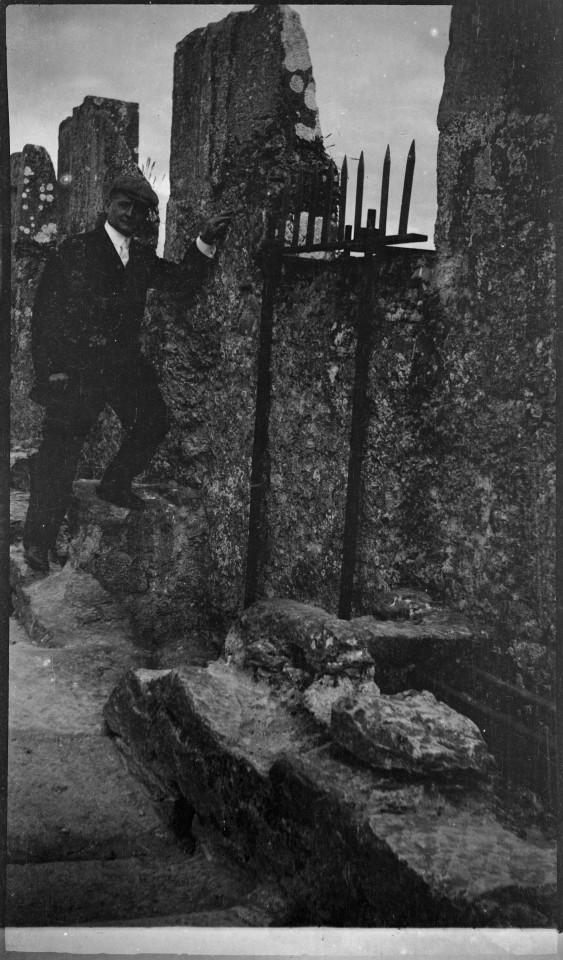
KFC1442N. John F. Fitzgerald at Blarney Castle in County Cork, Ireland, ca. August 8, 1908
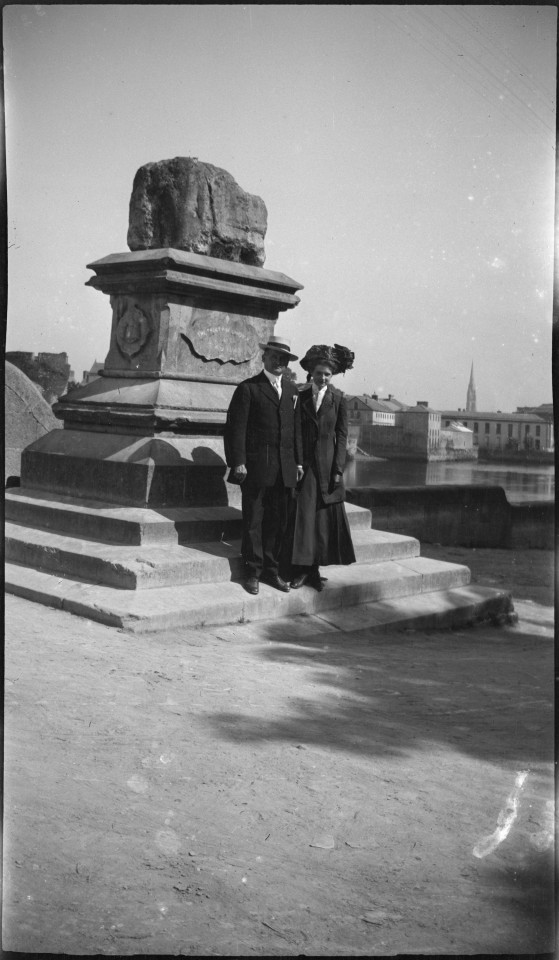
KFC1519N. John F. Fitzgerald and Agnes Fitzgerald Visit Treaty Stone of Limerick in Limerick, Ireland, ca. August 5, 1908
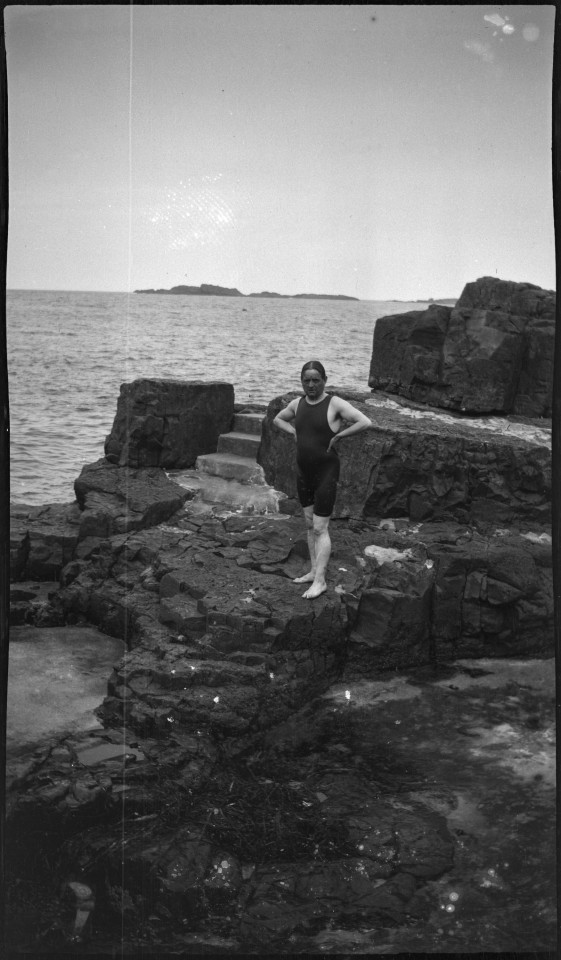
KFC1447N. John F. Fitzgerald Swims in Ireland, ca. August 1908-August 1909

KFC1430N. John F. Fitzgerald with Donkey in Ireland, ca. August 1908-August 1909
Read more about the project on the Library’s Blog. Photographs © John F. Kennedy Library Foundation.
#kennedy family#honey fitz#boston#ireland#black and white photographs#nitrate negatives#panama#palm beach
38 notes
·
View notes
Photo
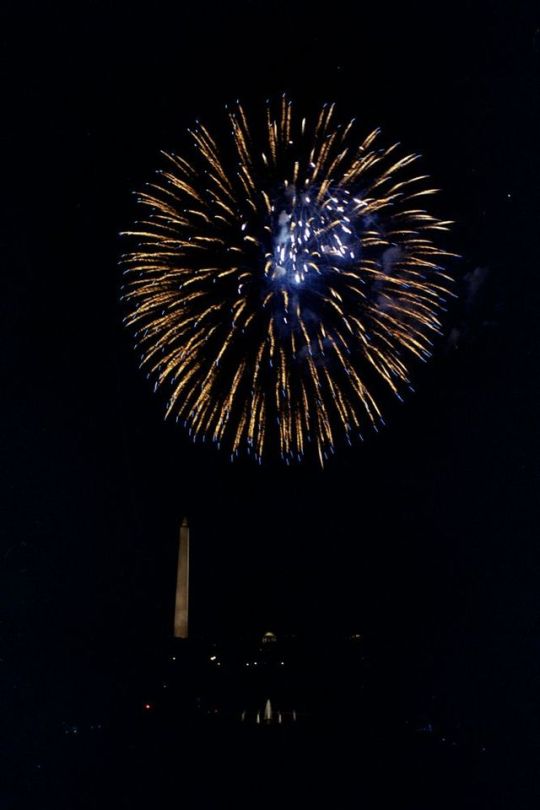
KN-C29875. Fireworks Show at the White House
In her 1964 Oral History with colleague Pamela Turnure, the First Lady’s Social Secretary Nancy Tuckerman described how the fireworks show at a state dinner honoring the King and Queen of Afghanistan (pictured above) came to be, and what President Kennedy’s reaction to it was.
Nancy Tuckerman: When the King and Queen of Afghanistan came, Mrs. Kennedy decided it would be appropriate to have a military review on the South Lawn of the White House. And then she decided something even more spectacular had to be done—because there had already been a military performance before. So she thought of fireworks, which they had never had at the White House, and the President, I remember, was very dubious and a little bit nervous about this because he thought it might be too much of an extravaganza and too much of a display to suddenly have fireworks bursting forth.
Mrs. Wayne Fredericks: Well, was he overruled on this or did he think about it?
Nancy Tuckerman: He thought about it a great deal. In fact, he thought about it so much that he called me constantly to find out if the fireworks came from Japan; how long they would last; and many other things: whether by law in Washington you could set them off other than the 4th of July—but we found out it was legal. He had a hundred questions which I had never thought about—and had no answers for—but found out.
...Also at the Afghanistan dinner, I remember, he suddenly got nervous again over the fireworks and about the day before the dinner he started into exactly the same routine that we had been through a few months ago. He said, “Well, I’ve decided now we must cut the fireworks in half.” So they went from ten minutes to five minutes, and the man who was setting off the fireworks didn’t quite understand or else he decided to make it more spectacular by putting the same amount of dynamite into five minutes because we’d paid for it… So suddenly when the fireworks went off it really was incredible. Do you remember? Oh, the noise! The switchboard in Washington, the police boards, everything was jammed up. People thought the end of the world had come.
Read the full Oral History.
19 notes
·
View notes
Text
Kennedy Family Collection Nitrate Negative Project: Voyages and Travel
From the early 1900s to about 1950, the Kennedy and Fitzgerald families documented their lives on nitrate photographic film. They were part of a new generation of amateur photographers utilizing a new medium that enabled them to produce numerous snapshots of everyday life – of friends and relatives, trips, holidays, and other celebratory occasions. When nitrate film became commercially available in the late 1880s, it made possible technical advancements in amateur roll film for smaller, more mobile cameras, ushering in the practice of family photography.
More than a century later, the surviving nitrate negatives from the Kennedy Family Collection have been digitized due in part to the inherently fragile and unstable nature of the medium but also to provide greater access and ensure future use while the physical objects remain safely preserved in their original format and condition.
The JFK Library is pleased to announce the completion of an 18-month grant project to catalog and provide online access to these newly digitized materials. Archivists created robust descriptions and metadata records for all of the nitrate negatives in the collection so that users can browse, search, and discover these historic photographs. Over 1,700 photographs are now available on the Library’s website. The nitrates represent a subset of photographic materials in a collection that provides access to the more personal, private moments of this prominent family not found in other historical sources.
These photos – the second in a series of posts to highlight images from this cataloging project - feature the Kennedy and Fitzgerald families as travelers and tourists, taking snapshots of historic sites and scenic views for the sake of personalizing their experiences abroad.
Follow Rose Fitzgerald on her travels as a young woman during her school year abroad (1908-1909), and with her father Mayor of Boston, John F. “Honey Fitz” Fitzgerald, during the Boston Chamber of Commerce tours of Europe (1911) and Panama (1913). Take note of the same countries her children would visit decades later. Or see the vacation spots the Kennedy family traveled to during their embassy years, when Joseph P. Kennedy, Sr., served as U.S. Ambassador to Great Britain.
Photographs © John F. Kennedy Library Foundation.

KFC1418N. Rose Fitzgerald and Agnes Fitzgerald with Unidentified Girl Aboard S.S. Cymric, ca. July 1908-August 1909

KFC1445N. Rose Fitzgerald at Windsor Castle in Windsor, Berkshire, England, ca. July-August, 1908

KFC1529N. Mayor John F. Fitzgerald and Rose Fitzgerald with Boston Chamber of Commerce Delegates at Royal Palace Gardens in Budapest, Hungary, ca. July-August, 1911

KFC1449N. Rose Fitzgerald Kisses Blarney Stone in County Cork, Ireland, ca. August 8, 1908

KFC675N. Kathleen Kennedy Kissing Blarney Stone in County Cork, Ireland, ca. July-August, 1937

KFC1452N. John F. Fitzgerald and Rose Fitzgerald at Giant's Causeway in County Antrim, Northern Ireland, ca. August 1909

KFC702N. Joseph P. Kennedy, Jr., Visits Giant's Causeway in Bushmills, Northern Ireland, ca. August 1937
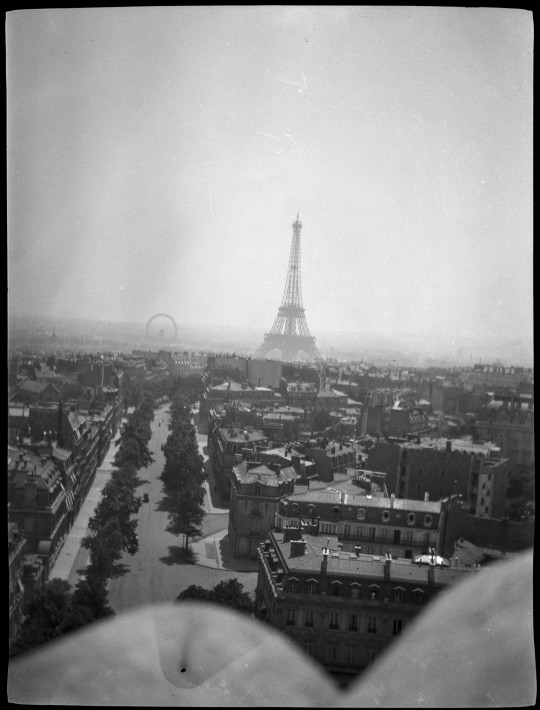
KFC1471N. View of Eiffel Tower and Ferris Wheel in Paris, France, ca. August 4-5, 1911

KFC2834N. Edward M. Kennedy at Hôtel des Invalides in Paris, France, ca. August 4, 1950
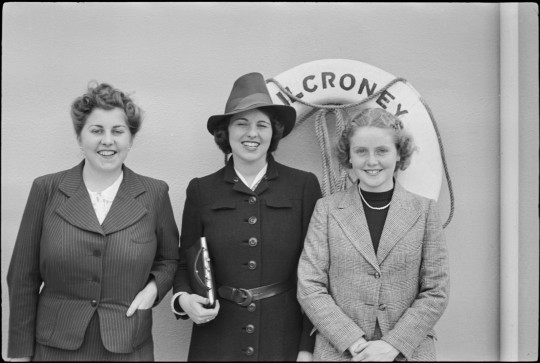
KFC1057N. Rosemary Kennedy and Betty Rice Visit Kilcroney Castle in County Wicklow, Ireland, ca. July 1-August 8, 1938

KFC646N. Kathleen Kennedy Visits Doge's Palace in Venice, Italy, March 30, 1936

KFC711N. View of Killiney Beach in Killiney, Ireland, ca. July-August, 1937
Read more about the project on the Library’s Blog. Photographs © John F. Kennedy Library Foundation.
#kennedy family#nitrate negatives#rosemary kennedy#rose kennedy#joe kennedy jr#edward m kennedy#kathleen kennedy#black and white photographs#photography#ireland#venice#paris#blarney stone#windsor castle#john f fitzgerald#honey fitz
51 notes
·
View notes
Text
Public Opinion in the JFK Library Archives: School Prayer and the Supreme Court, June 25, 1962
Stacey Chandler, Reference Archivist
In 1958, starting the school day with the Pledge of Allegiance was pretty routine for American kids. But mornings became a bit more complicated that year for students in New Hyde Park, New York, where the local public school board started requiring teachers to lead a class prayer (written by the state’s Board of Regents) after the Pledge each day. It didn’t take long for local dad Steven Engel and a few like-minded parents to challenge School Board President William Vitale on the prayer’s constitutionality, bringing the issue of school-sponsored prayer into the national spotlight and sparking controversy across the political spectrum.
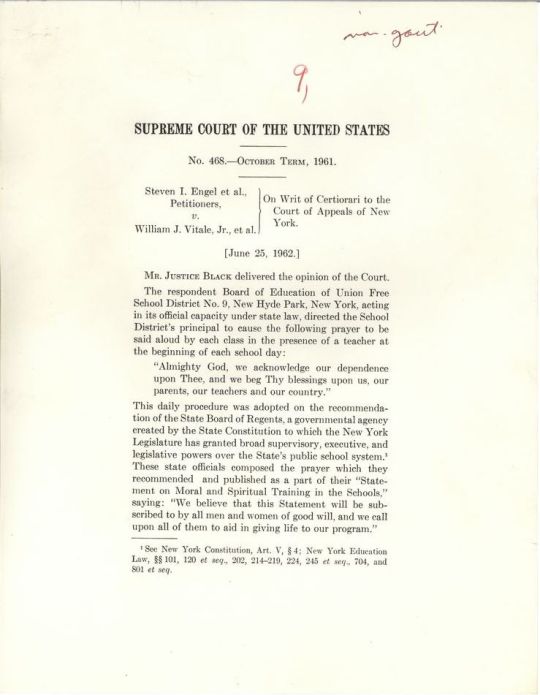
JFKPOF-056a-005-p0025
As Engel v. Vitale made its way through New York’s courts, judges sided with Vitale and school prayer three times, stressing that students could leave the room if they didn’t want to participate. But on June 25, 1962, after hearings at the U.S. Supreme Court, Justice Hugo Black delivered the 6-1 decision that reversed the lower court’s ruling and deemed school-sponsored prayer unconstitutional:
We think that by using its public school system to encourage recitation of the Regents’ prayer, the State of New York has adopted a practice wholly inconsistent with the Establishment Clause. …When the power, prestige and financial support of government is placed behind a particular religious belief, the indirect coercive pressure upon religious minorities to conform to the prevailing officially approved religion is plain.
Though the ruling banned only official school-sponsored prayer and didn’t impact individual students’ rights to pray on school grounds, it motivated people across the United States to write to President John F. Kennedy with their thoughts about the role of prayer in public life. Their letters are now part of the archives at John F. Kennedy Presidential Library, where archivists are working on preserving and describing them.

Damaging materials removed from the Public Opinion Mail collection during preservation.
In the two weeks after the decision, the White House Mail Room saw nearly 1,000 letters on the topic; only 13 of those, a staff member noticed, supported the Supreme Court’s ruling. Most writers brought up Communism or the Soviet Union, echoing the comments of politicians like Alvin O’Konski of Wisconsin, who suggested the Court was “doing everything possible to help Khrushchev bury us.” Meanwhile, children (often writing as part of a Sunday school class) worried they wouldn’t be allowed to pray in school at all.

JFKMPFPOM-1202-001

JFKWHCSF-0886-008
Others attacked the communities associated with the families involved in the case, who identified as atheist, Ethical Culturalist, Jewish, and Unitarian:
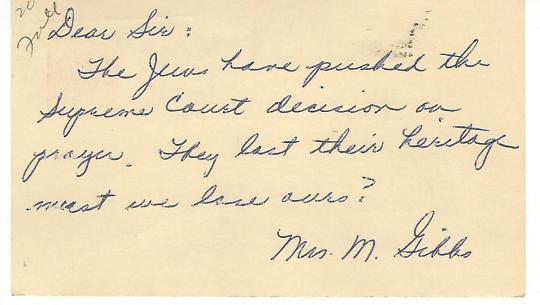
JFKMPFPOM-1202-002

JFKMPFPOM-1202-002
While the letters arrived, JFK was preparing for a previously-scheduled June 27 press conference. Expecting that he’d be asked about Engel v. Vitale, the President’s staff put together a few draft statements, including one that expressed sympathy with the dissenting opinion. But when a reporter asked “Can you give us your opinion of the decision itself?” JFK ditched the prepared remarks and said:
We have in this case a very easy remedy, and that is to pray ourselves. …I would hope that as a result of this decision that all American parents will intensify their efforts at home, and the rest of us will support the Constitution and the responsibility of the Supreme Court in interpreting it.
JFK’s comments sparked a second wave of letters, and most writers expressed concern over what they interpreted as outright support for the Court’s ruling.
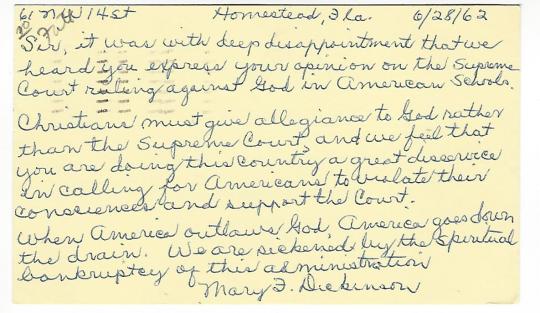
JFKMPFPOM-1202-002
One of these writers was New York fifth-grader Tom Mallon, who later reflected that his own letter “based on a misapprehension (Kennedy was not supporting the Court’s decision per se), shows a stiff anger.”

JFKWHCNF-1709-007
But not all of the letters about JFK’s comments were critical. Scattered throughout the boxes of mail on this topic are letters from leaders of organizations like the American Civil Liberties Union (ACLU) and the United Parents Association of New York City, who wrote in to express their approval of his remarks.

JFKWHCSF-0886-009
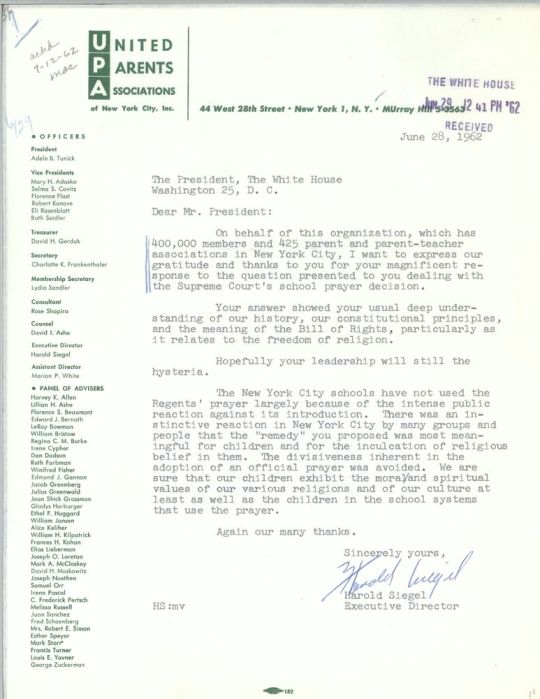
JFKWHCSF-0886-008
By the end of 1962, the flood of White House mail about the case was over – but the controversy wasn’t. In December (after receiving many constituent letters of their own), members of the House of Representatives voted to inscribe “In God We Trust” on the wall in the House Chamber, in what Congressman William Randall of Missouri called “our answer to the recent decision of the U.S. Supreme Court order banning the Regents’ prayer.” But even as the words were mounted on the Chamber wall, another landmark case was on its way to the Supreme Court – Abington School District v. Schempp – that would end Pennsylvania public schools’ required Bible readings in June 1963.
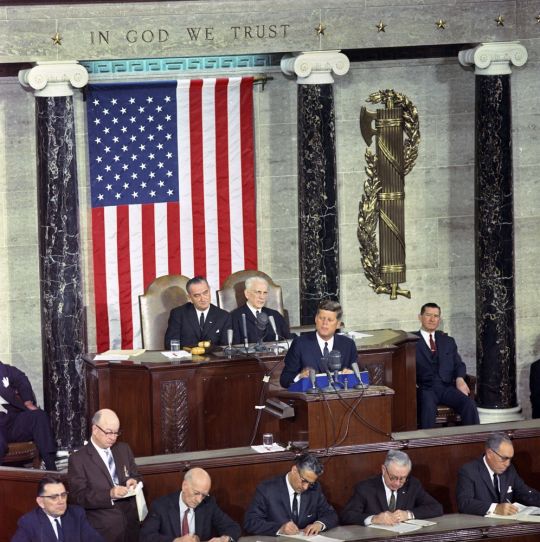
JFKWHP-ST-C7-2-63. John F. Kennedy delivers his State of the Union Address in January 1963 under the newly-installed “In God We Trust” inscription.
While a 1962 Gallup poll tells us that 79% of Americans approved of “religious observances in public schools,” polls can’t always reveal what’s hidden behind the numbers: the beliefs, attitudes, and understandings about an issue that contribute to each person’s opinion of it. Letters from the public can capture the perspectives that raw numbers can miss, and we’re working to preserve these materials for future study of decisions like Engel v. Vitale and their lasting impact on American politics and culture.
36 notes
·
View notes
Text
Kennedy Family Collection Nitrate Negative Project: The Everyday
From the early 1900s to about 1950, the Kennedy and Fitzgerald families documented their lives on nitrate photographic film. They were part of a new generation of amateur photographers utilizing a new medium that enabled them to produce numerous snapshots of everyday life – of friends and relatives, trips, holidays, and other celebratory occasions. When nitrate film became commercially available in the late 1880s, it made possible technical advancements in amateur roll film for smaller, more mobile cameras, ushering in the practice of family photography.
More than a century later, the surviving nitrate negatives from the Kennedy Family Collection have been digitized due in part to the inherently fragile and unstable nature of the medium but also to provide greater access and ensure future use while the physical objects remain safely preserved in their original format and condition.
The JFK Library is pleased to announce the completion of an 18-month grant project to catalog and provide online access to these newly digitized materials. Archivists created robust descriptions and metadata records for all of the nitrate negatives in the collection so that users can browse, search, and discover these historic photographs. Over 1,700 photographs are now available on the Library’s website. The nitrates represent a subset of photographic materials in a collection that provides access to the more personal, private moments of this prominent family not found in other historical sources.
These photos – the first in a series of posts to highlight images from this cataloging project - feature the Kennedy and Fitzgerald families in more informal settings, at home and at play.
Photographs © John F. Kennedy Library Foundation.

KFC233N. John F. Kennedy, Rosemary Kennedy, Eunice Kennedy, and Patricia Kennedy in Brookline, Massachusetts, May 1926
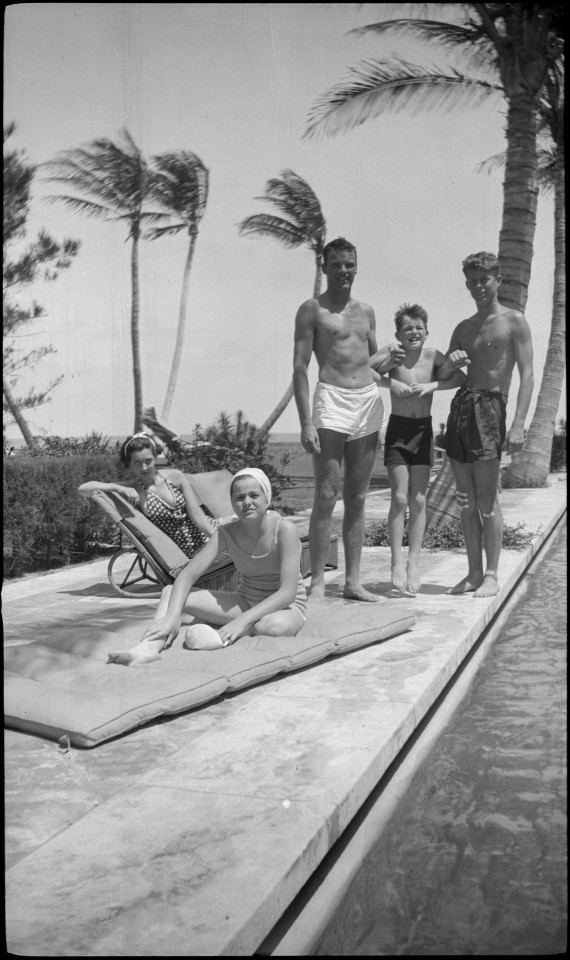
KFC576N. John F. Kennedy, Patricia Kennedy, Robert F. Kennedy, and Friends in Palm Beach, Florida, April 1936.
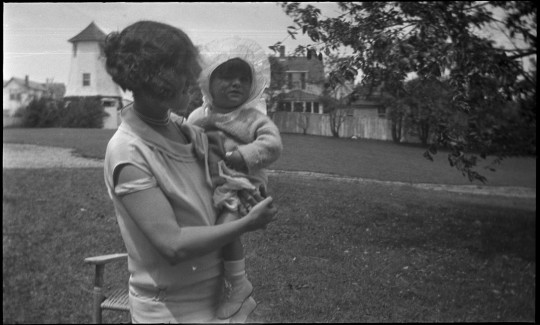
KFC51N. Rose Fitzgerald Kennedy with Patricia Kennedy at Malcolm Cottage in Hyannis Port, Massachusetts, 1925

KFC888N. Joseph P. Kennedy, Sr., and Patrick Joseph Kennedy with Joseph P. Kennedy, Jr., at Nantasket Beach, Massachusetts, ca. 1917

KFC1946N. John F. Kennedy, Rosemary Kennedy, Kathleen Kennedy, and Eunice Kennedy in Brookline, Massachusetts, ca. 1924-1925
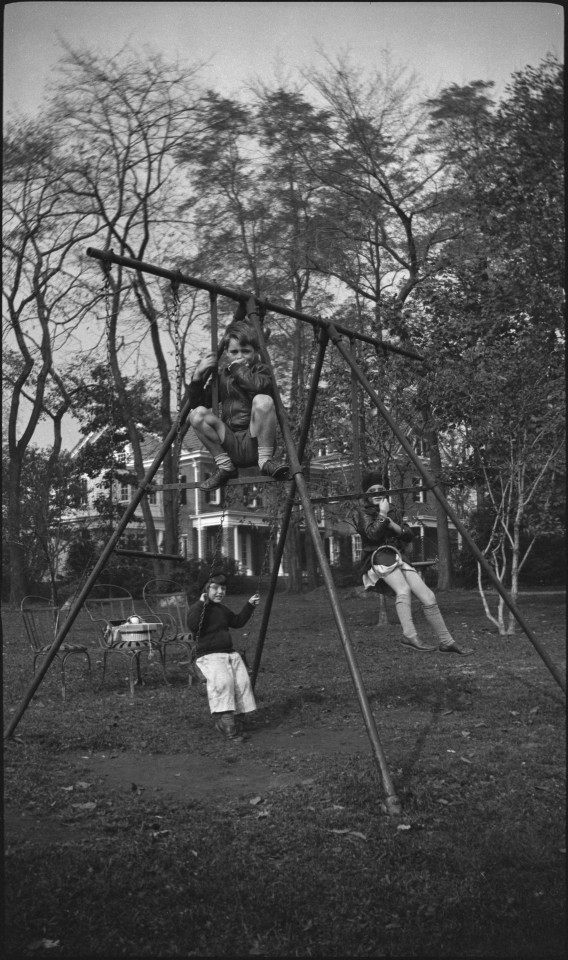
KFC530N. Robert F. Kennedy, Jean Kennedy, and Edward M. Kennedy Play on Swing Set in Bronxville, New York, October 1934

KFC2725N. Edward M. Kennedy in Bronxville, New York, ca. 1936

KFC2069N. Eunice Fitzgerald with Chickens in Dorchester, Massachusetts, ca. 1910-1913
Read more about this project on the Library’s Blog.
#kennedy family#nitrate negatives#john f. kennedy#rosemary kennedy#edward m. kennedy#robert f. kennedy#rose kennedy#jean kennedy smith#kathleen kennedy#eunice kennedy shriver#joseph p. kennedy#patricia kennedy lawford#black and white photographs
141 notes
·
View notes
Audio
On May 15, 1963, Major Gordon Cooper was launched in the space capsule Faith 7 to fly the last manned space mission for Project Mercury. In fewer than 35 hours, he completed 22 orbits of the Earth, each orbit taking about 88 minutes. After splashdown in the Pacific Ocean, President Kennedy called Major Cooper to congratulate him. Listen in to their conversation. JFKPOF-TPH-19A-3
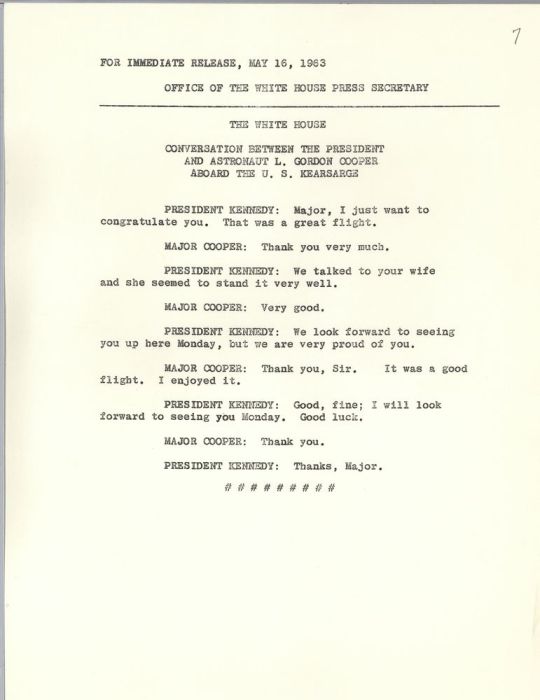
JFKPOF-095-021-p0014
PRESIDENT KENNEDY: Major, I just want to congratulate you. That was a great flight.
MAJOR COOPER: Thank you very much.
PRESIDENT KENNEDY: We talked to your wife and she seemed to stand it very well.
MAJOR COOPER: Very good.
PRESIDENT KENNEDY: We look forward to seeing you up here Monday, but we are very proud of you.
MAJOR COOPER: Thank you, sir. It was a good flight. I enjoyed it.
PRESIDENT KENNEDY: Good, fine; I will look forward to seeing you on Monday. Good luck.
MAJOR COOPER: Thank you.
PRESIDENT KENNEDY: Thanks, Major.
23 notes
·
View notes
Photo

A page from Hosea Williams' newspaper, The Crusader: an announcement to join The March for the Ballot on March 1, 1964, to be led by a group of high school students called the Youth Crusaders. See more on protests in Georgia in the 1960s.
92 notes
·
View notes
Audio
John Glenn became the first American to orbit the Earth on February 20, 1962, piloting the space capsule Friendship 7. JFK watched his historic flight from the White House, and called Glenn following his splashdown in the North Atlantic Ocean. Listen in to their conversation. WH-075-002

JFKPOF-030-001-p0004
THE PRESIDENT: Hello?
COL. GLENN: Hello, sir.
THE PRESIDENT: Colonel?
COL. GLENN: This is Colonel Glenn.
THE PRESIDENT: Listen, Colonel, we are really proud of you, and I must say you did a wonderful job.
COL. GLENN: Thanks, Mr. President.
THE PRESIDENT: We are glad you got down in very good shape. I have just been watching your father and mother on television, and they seemed very happy.
COL. GLENN: It was a wonderful trip -- almost unbelievable, thinking back on it right now. But it was really tremendous.
THE PRESIDENT: Well, I am coming down to Canaveral on Friday, and hope you will come up to Washington on Monday or Tuesday, and we will be looking forward to seeing you there.
COL. GLENN: Fine. I will certainly look forward to it.
31 notes
·
View notes